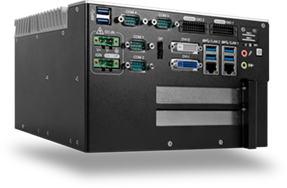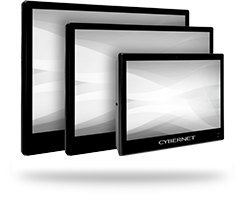Dust is more than an eyesore clinging to your computer’s monitor; it is a serious maintenance and reliability concern that must be addressed. Understanding how to clean out dust from a PC and the measures you can take to protect against dust buildup are critical for being a responsible owner.
How Does Dust Affect a PC?
Dust is one of the most common maintenance and reliability issues for computers across various industries and use cases. Whether it’s a gaming computer at home or a rugged mini PC on a factory floor, dust can impair its operations and even cause a complete breakdown.
Insulation and Heat Buildup
The most common issue caused by dust is heat buildup due to insulation. If dust is allowed to settle on a computer’s circuit board, it prevents those components from radiating the heat they generate during operation. This trapped heat can lead to performance loss as the computer deliberately throttles itself to counter the heat. In a worst-case scenario, it can even lead to permanent damage as the computer components fry themselves.
Electrical Shorts
In certain cases, such as in an industrial work environment with lots of metal shavings in the air, dust buildup inside the PC can lead to electrical shorts. This is because the metal shavings in the dust provide a new path for electricity to flow, bypassing the load circuit and causing an excess of power to flow through the system. In turn, this can lead to equipment damage, fires, and even injure workers using the equipment.
Clogged Ports and Drives
Outside of the circuit board, dust can interfere with other parts of a computer. For example, it can clog a disk drive’s platter and prevent it from spinning correctly, making it impossible to read the data saved to that drive. Dust can also interfere with I/O ports, causing poor contact between components and rendering peripheral devices unusable. Lastly, it is an obstructive eyesore on a computer’s monitor, obscuring information and interfering with touchscreen displays.
Signs of Dust Build-Up
Being a responsible computer owner involves being aware of the early warning signs of dust buildup. If your PC exhibits any of these issues, it may be time to give it a good cleaning.
Visible Dust Build-Up
First and most obviously, if there is a lot of dust clinging to your computer’s screen, vents, or casing, there’s a good chance that it has also gotten inside the computer. This is less of a concern if your computer has a high ingress protection rating, as the dustproof casing should effectively lock out any particles from entering and affecting the components within.
Louder Fans
Most computers rely on spinning fans to keep their circuits cool. Unfortunately, these same fans blow dust into the casing and onto the components they’re trying to cool. As dust accumulates on circuitry and insulates the heat they generate, fans spin faster and blow harder to try to offset this rising heat. If your computer’s fans are consistently louder than they’ve been in the past, it may be time to check inside and see if there’s a dust issue.
Hot To The Touch
While some amount of heat during operations is normal, a computer being unusually hot to the touch should be a serious cause for concern. This is often a warning sign that your computer’s cooling system can’t keep up with the dust accumulating inside. There are also free online programs available that you can use to measure the temperature of your PC’s components. In general, a safe CPU temperature range is roughly 30 to 50°C, and up to 90°C during particularly demanding tasks.
How to Clean Out Dust From Your PC
Thankfully, knowing how to clean dust from a PC is a relatively simple task that doesn’t require any specialized training to perform. These steps are universal for virtually any computer in any role or sector.
- Purchase a can of compressed air designed for cleaning out PCs. These cans are pressurized specifically to blow dust out of the case without disrupting or damaging the more delicate parts of the computer. Do not use a commercial or industrial vacuum cleaner, as they can easily damage components.
- Turn off the computer, unplug it, and wait for approximately half an hour while it cools completely.
- Take the PC to a well-ventilated area, such as outdoors or in a large garage, and open the case.
- Remove the most significant chunks of dust and grime by hand (we’d recommend gloves for this part). You can also use cotton swabs or microfiber cloths to wipe away clumps. If this involves directly touching or handling components inside the PC, make sure you wear an antistatic wrist strap. This will prevent any electrostatic discharge from occurring, which could damage those components.
- Use the compressed air can to spray down vents, fans, the CPU, heat sinks, I/O ports, and any other nooks and crannies where dust can settle and collect.
- Reinstall any components you may have removed during cleaning, close the case, plug the PC back in, and return to your usual workflow.
The frequency at which you clean a computer will depend on its operating environment and design. For example, a computer used in a typical office setting typically requires cleaning only once a year or so. Computers in workspaces with lots of airborne particles, such as construction sites and industrial complexes, will require more frequent cleaning.
Fanless PCs: The Alternative Solution
If you’d rather avoid dealing with dust buildup inside your PC, consider investing in a fanless computer instead. Fanless industrial panel PCs and mini PCs rely on fanless cooling to dissipate heat, rather than relying on noisy, unreliable fans that also blow dust into the casing. Fanless computers are also a common fixture in healthcare settings, as cooling fans can blow microbes throughout a hospital and spread disease.
Dustproof and Fanless PCs from Cybernet Manufacturing
Knowing how to clean dust from a PC is one of the most basic but important maintenance responsibilities for any informed owner. Alternatively, investing in a fanless computer can be the perfect way to counter a work environment with high amounts of dust in the air.
If your company is looking for dust-resistant and fanless computers, contact Cybernet Manufacturing. Our range of industrial and medical computers features IP65 sealed front bezels and fanless cooling, all to prevent dust from entering the casing and improve reliability. Our commitment to quality and durability ensures that our devices have a failure rate of less than 0.05%.

